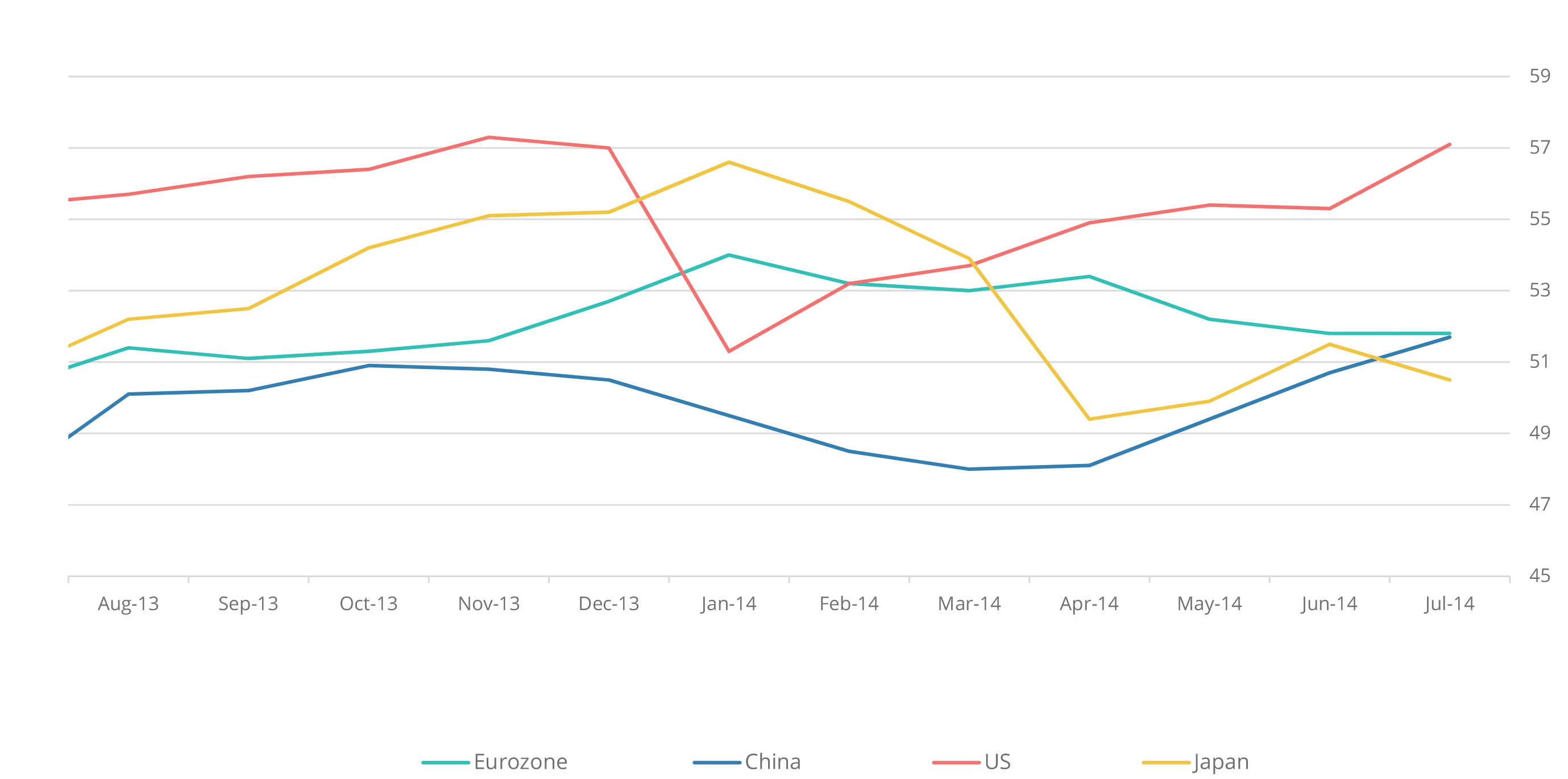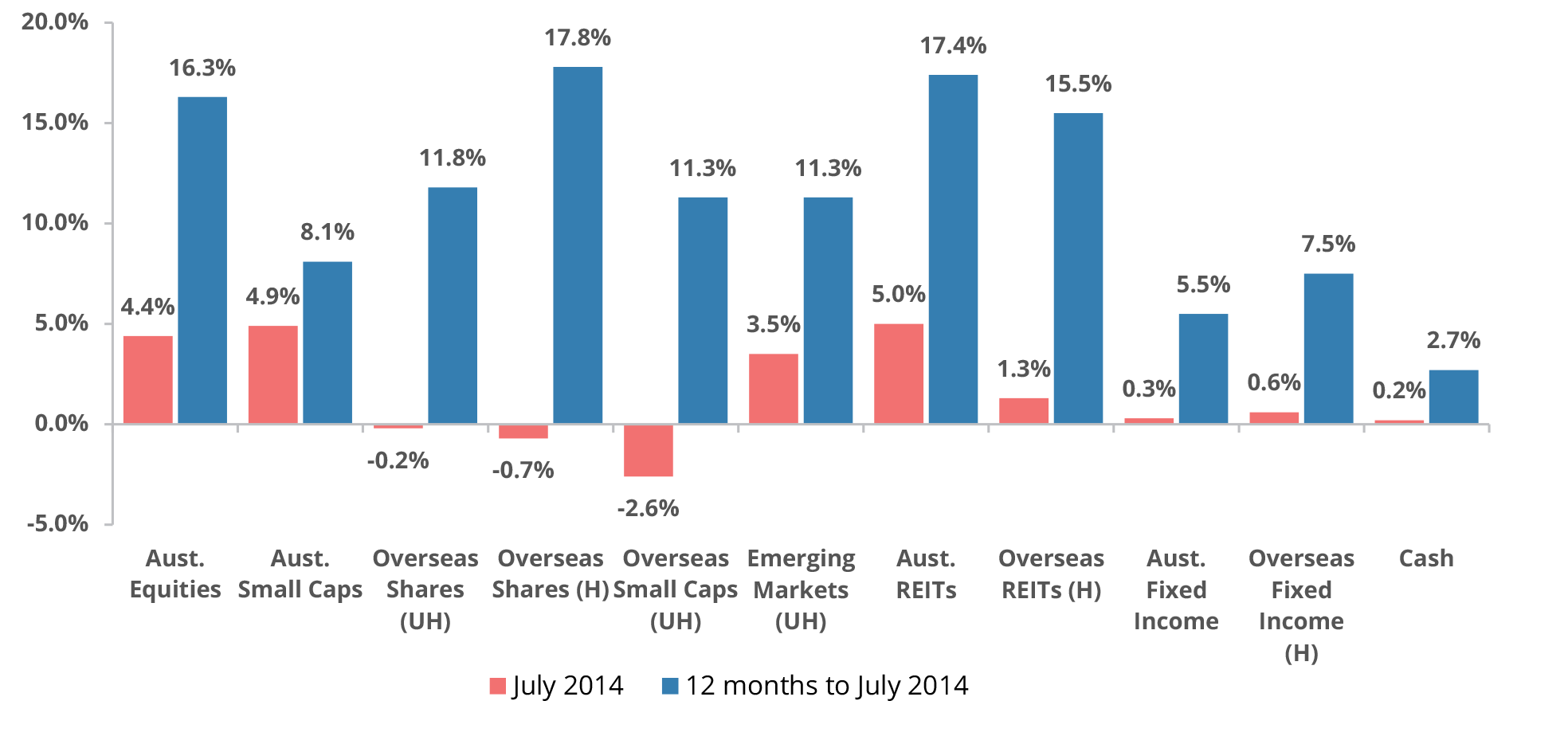Director’s Perspective
By Inbam Devadason
Global share markets have performed well during the 2014 calendar year. Confidence is growing in the US recovery. US interest rates are expected to remain on hold for at least 6 months which will continue to stimulate their economy. Europe’s Purchasing Manufacturers Index (PMI) is now above 50, signalling expansion. Global PMI’s remain strong across all major economic regions (see table below). Australian company profit reporting has been better than expected. Dividends announced by most companies are higher than last year and this has sparked a strong rally in the market since 30 June 2014. The key risk remains the continued reliance on central banks keeping official interest rates very low, a slow down in European economic growth and China’s recent small property price fall and corporate credit default risk issues.
Regional Commentary
Australia
Monetary policy – the Reserve Bank of Australia (RBA) left the cash rate unchanged at 2.5% at their August 2014 meeting for the eleventh consecutive month. Although the annual rate of inflation rose 0.5% to 3.0% in the June quarter of 2014 and is now currently at the upper end of the RBA’s target range of 2% to 3%, it is forecast to slow to 2.8% for the September Quarter of 2014.
Retail – According to ABS data, Australian retail sales grew by 0.6% in June 2014. This was positive following a fall (revised) of 0.3% in May 2014. Australian turnover rose 5.5% in the 12 months to June 2014 compared with the 12 months to June 2013.
Employment – The Australian economy lost 300 jobs in July 2014, while the participation rate increased by 0.1% to 64.8%. The overall seasonally adjusted unemployment rate rose 0.3% to 6.4% (up from 6.1% in June).
United States
Growth – The annual GDP growth rate in the US for the June quarter 2014 increased to 4.0% based on early estimates – showing significant improvement from the previous quarter which recorded a lower than expected annual GDP Growth rate of -2.9%.
Manufacturing – The US ISM Manufacturing PMI rose to 57.1 in July 2014, up from 55.3 in June. This represents 13 consecutive months of growth in US manufacturing.
Employment – The US unemployment rate rose slightly to 6.2% in July 2014 (an increase of 0.1% from June) despite the US economy creating 209,000 jobs. Job gains were led by strong employment growth in professional and business services, construction and retail trade.
Europe
Employment – The official Eurozone rate of unemployment fell slightly by 0.1% to 11.5% in June 2014 (down from 11.6% in May). It has fallen 0.5% in the past 12 months (down from 12.0% in June 2013).
Manufacturing – Manufacturing within the Eurozone continued to improve for the thirteenth consecutive month in June 2014. However the pace of improvement remained steady with the Eurozone Manufacturing PMI at 51.8 for the month.
China/Japan
Inflation – Chinese annual inflation remained steady at 2.3%, which was in line with forecast expectations. Although this remains below the Government’s stated target rate of 3.5% pa, the positive overall growth result has continued to give investors confidence that China will be able to avoid entering a period of deflation.
Manufacturing – Manufacturing in China continued to rise in July 2014. The HSBC PMI increased from 50.7 in June 2014 to 51.7 in July 2014. This is the strongest that Chinese manufacturing has been since early 2013.
Manufacturing activity in Japan also continued to expand in July. However, the rate of expansion slowed slightly with the Japanese manufacturing PMI falling to 50.5 for the month (down from 51.5 in June).
Selected Global Manufacturing PMI Indicators
As at 31 July 2014
Source: RBA, ABS. Prepared by Harvest Financial Group
Commodity Prices
Commodity prices were generally weaker in July 2014. Gold prices fell 2.8% to finish the month at US$1,286.06/oz. The price of Oil also fell sharply finishing the month down 7.23% to US$104.63/bbl. Iron Ore prices were the notable exception, with the price per metric tonne increasing by 1.1% to US$96.0 in July.
 The Australian share market has performed well in July and August 2014. The main driver has been a better than expected profit reporting for the year ending 30 June 2014. Our belief is that the market is still currently at fair value. We expect the Australian Equity market (as measures by the ASX 200 price index) to continue to trade between 5,300 and 5,900 for the remainder of 2014.[/jbox]
The Australian share market has performed well in July and August 2014. The main driver has been a better than expected profit reporting for the year ending 30 June 2014. Our belief is that the market is still currently at fair value. We expect the Australian Equity market (as measures by the ASX 200 price index) to continue to trade between 5,300 and 5,900 for the remainder of 2014.[/jbox]
Asset Class Returns for Selected Market Indicators
As at 31 July 2014
Selected Market Indicators Commentary
For the Month Ended 31 July 2014
Australian Shares
The Australian share market rose +4.4% in July 2014 with positive returns recorded across most of the market. Investors drew renewed confidence the announcement of higher than expected CPI inflation result for the June Quarter of 2014.
The best performing sectors for the month of July were Materials (+3.3%) and IT (+3.3%). The weakest performing sectors for the month were Utilities (-3.6%) and Energy (-2.2%).
Global Shares
Global share markets were generally down in July 2014 with the MSCI World (ex. Australia) Index falling -0.7% on a fully hedged basis on the back of investor concern over the escalating geopolitical conflicts in the Middle East.
The strongest performing global sectors for the month were IT (+2.8%), Materials (+1.1%) and Telecommunication Services (+2.0%), while the weakest sectors were Industrials (-1.8%), Energy (-2.5%) and Utilities (-3.3%).
Markets in the U.S. were down with the S&P 500 Composite Index (-1.4%), the NASDAQ (-0.87%) and the Dow Jones (-1.4%) all down.
European Markets followed suit and were generally down in July 2014. European markets in particular were adversely affected by economic sanctions placed on Russia in the wake of the continuing conflict within the Ukraine. Markets in the UK (-0.12%), France (-4.0%) and Germany (-4.3%) all recorded negative returns for the month.
Asian markets were generally up with the Chinese Shanghai Composite Index (+7.5%) being the strongest performing while the Indian BSE 500 (+0.41%) and the Japanese Topix (+2.1%) also made positive returns.
Property
Domestic Real Estate Investment Trusts (REITs) were up +5.0% in July 2014 while Global REIT’s were down, returning -2.0% on a fully hedged basis.
Fixed Interest (Bonds)
Global sovereign bond yields were mixed in July 2014 with 10 year bond yields falling in the UK (-5bps to 2.62%), Germany (-8 bps to 1.17%) and Japan (-3bps to 0.54%), while in the US, 10 year bond yields rose +4bps to 2.56%. Australian bond yields were also mixed in July with 10 year bond yields falling (-3bps to 3.51%), while 5 year bond yields rose (+1bps to 3.00%).
Australian Dollar
The Australian dollar was mixed against other major currencies in July. The A$ depreciated against the US$, finishing the month at US$0.93. The A$ also depreciated against the Pound Sterling (-0.4%) while it appreciated against the Euro (+0.8%) and the Japanese Yen (+0.4%).
© 2014 Harvest Employee Benefits. This newsletter has been prepared for Harvest’ clients and the information contained herein is correct and up to date at the time it was prepared. Harvest Employee Benefits Pty Ltd (ABN 74 107 226 693) is a Corporate Authorised Representative and Mario Isaias, Noel Hucker and Inbam Devadason are Authorised Representatives of Harvest Financial Group Pty Ltd (ABN 80 111 998 068, AFSL No. 284909). No information in this newsletter should in any way be construed as an investment recommendation of any kind. Harvest reserves the right to correct any errors or omissions. Any views expressed herein are the views of the author/s and could involve assumptions which may or may not prove valid. These are subject to change at without notice. This newsletter has been prepared without taking into account any individual person’s objectives, financial situation and needs. A person should carefully consider their personal objectives, situation and needs before taking any action based on the information contained in this newsletter.
[/jbox]
Click Here to download a PDF version of this newsletter






Leave A Comment
You must be logged in to post a comment.